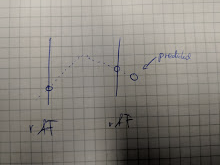Intent to Implement: PointerEvent.getPredictedEvents
eir...@chromium.org
Contact emails
eir...@chromium.org.com, nzol...@chromium.org
Explainer
https://docs.google.com/document/d/15NKd4s5BSEPXQZ1IJnm9zNzz7hltIRw0YOMlN5WoOzA/edit#
DemoPage: eirage.github.io/Prediction/test
Spec
https://w3c.github.io/pointerevents/extension.html#extensions-to-the-pointerevent-interface
Summary
An API to return a few(~3 for now) predicted events of the received events in javascript. This API enables apps like drawing app to draw the predicted line in advance, so users feel less latency.
Motivation
One of the existing gaps between native apps and web apps is the latency of the input. This is particularly more visible in drawing apps. A way to make users feel like the lines they are drawing appear in the realtime is to predict where user will draw next and they pre-draw that point as well. These APIs are provided by different platforms, and web platform is lacking such an API.
Interoperability and Compatibility Risk
This is a new API so there’ll be no compatibility change.
Edge: No signals
Firefox: No signals
Safari: No signals
Web developers: No signals
Will this feature be supported on all six Blink platforms (Windows, Mac, Linux, Chrome OS, Android, and Android WebView)?
Yes
Link to entry on the feature dashboard
https://www.chromestatus.com/feature/5765569655603200
Requesting approval to ship?
No
Jochen Eisinger
--
You received this message because you are subscribed to the Google Groups "blink-dev" group.
To view this discussion on the web visit https://groups.google.com/a/chromium.org/d/msgid/blink-dev/56400959-294c-47d6-ac98-1e247908882d%40chromium.org.
Ella Ge
Rick Byers
To view this discussion on the web visit https://groups.google.com/a/chromium.org/d/msgid/blink-dev/CADo_Rti9sciWKgY5nLAuAytJ1PohhtpkHvKhbthPHjJQTEtmrw%40mail.gmail.com.
Jochen Eisinger

Rick Byers
To view this discussion on the web visit https://groups.google.com/a/chromium.org/d/msgid/blink-dev/CALjhuieHmvp87QFdfCh1ynD%2Br2s8P%3D_FFymT33-0qH1mpvzTWA%40mail.gmail.com.
Jochen Eisinger
Ella Ge
Jochen Eisinger
Navid Zolghadr
To view this discussion on the web visit https://groups.google.com/a/chromium.org/d/msgid/blink-dev/CALjhuidqUgSe90u-tUi8WR4BjrFdusDzYX9Hzw5WM8vDS3hVQQ%40mail.gmail.com.
